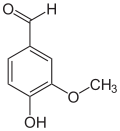Vanilloids
The vanilloids are compounds which possess a vanillyl group. They include vanillyl alcohol, vanillin, vanillic acid, acetovanillon, vanillylmandelic acid, homovanillic acid, capsaicin, etc. Isomers are the isovanilloids.





vanillyl alcohol vanillin vanillic acid acetovanillon Vanillylamine
A number of vanilloids, most notably capsaicin, bind to the transient receptor potential vanilloid type 1 (TRPV1) receptor, an ion channel which naturally responds to noxious stimuli such as high temperatures and acidic pH.[1] This action is responsible for the burning sensation experienced after eating spicy peppers.
Outside the food industry vanilloids such as nonivamide are used commercially in pepper spray formulations.
Other vanilloids which act at TRPV1 include resiniferatoxin and olvanil.
References
Literature
- Lee, Jeewoo; Uk Kang, Sang; Yeon Kim, Su; Eun Kim, Sung; Joon Jo, Yeong; Kim, Sunghoon (2001). "Vanilloid and Isovanilloid Analogues as Inhibitors of Methionyl-tRNA and Isoleucyl-tRNA Synthetases" (PDF). Bioorganic & Medicinal Chemistry Letters. 11 (8): 965–968. doi:10.1016/S0960-894X(01)00096-8. PMID 11327601.
This article is issued from Wikipedia - version of the 3/15/2016. The text is available under the Creative Commons Attribution/Share Alike but additional terms may apply for the media files.